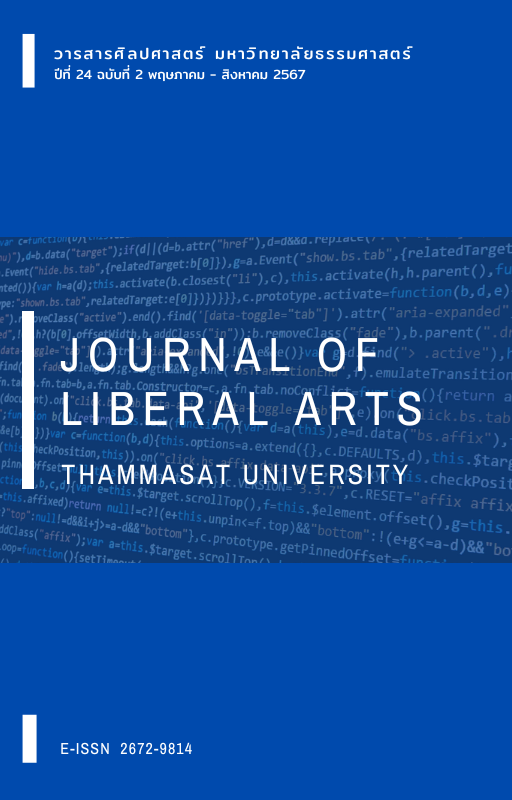สหวาทกรรมและเรื่องเล่าจากบุคคล Intersex ในสังคมไทย
Main Article Content
บทคัดย่อ
ร่างกายของบุคคล Intersex เผชิญกับข้อจำกัดด้านความรู้ แม้กระทั่งในการขับเคลื่อนด้านความหลากหลายทางเพศ ประเด็น Intersex ยังไม่มีสถานะเป็นความจริงกระแสหลัก บทความวิจัยนี้วิเคราะห์และตีความเรื่องเล่าชีวิตของบุคคล Intersex ในบริบทสังคมไทยด้วยแนวคิดสหวาทกรรม รวบรวมเรื่องเล่าจากการสัมภาษณ์ที่เผยแพร่ผ่านสื่อสาธารณะ บทความวิจัยนี้ดำเนินตามระเบียบวิธีวิจัยเชิงคุณภาพเพื่อตอบคำถามในประเด็นร่างกายและตัวตน รวมถึงแนวปฏิบัติที่สัมพันธ์กับวาทกรรมหลายเสียง ผลการวิจัยพบว่าความเป็นจริงเรื่อง Intersex ในบริบทสังคมไทยไม่มีเอกภาพ วาทกรรมวิทยาศาสตร์การแพทย์และวาทกรรมเพศคู่ตรงข้ามเชื่อมต่อกันเพื่อสร้างความเข้าใจว่า พัฒนาการทางเพศในกลุ่ม Intersex ผิดปกติ คลุมเครือ รับรู้ไม่ได้ และจำเป็นต้องรักษา แต่เมื่อวาทกรรมวิทยาศาสตร์การแพทย์และวาทกรรมเพศคู่ตรงข้ามเชื่อมต่อกับวาทกรรม Intersex หลังสมัยใหม่ ร่างกายบุคคล Intersex ในขอบเขตนี้สามารถรับรู้ได้ในฐานะของความหลากหลายทางกายวิภาค ซึ่งไม่ใช่อาการผิดปกติความหมายใหม่อนุญาตให้บุคคล Intersex โต้ตอบและปฏิเสธขั้นตอนแทรกแซงทางการแพทย์ได้ ซึ่งสนับสนุนความเป็นไปได้ที่ร่างกายของบุคคล Intersex จะถูกรับรู้มากขึ้นในสังคมไทย
Downloads
Article Details

อนุญาตภายใต้เงื่อนไข Creative Commons Attribution-NonCommercial-NoDerivatives 4.0 International License.
เอกสารอ้างอิง
นฤพนธ์ ด้วงวิเศษ. (2559). เพศและความเป็นชายในพุทธศาสนากับการควบคุมภิกษุสามเณร และบัณเฑาะก์. วารสารสังคมศาสตร์ มหาวิทยาลัยนเรศวร, 12(1), 3-25.
ไพรลฎา อยู่มั่น. (2559). อำนาจกระทำ: ศึกษาการให้ความยินยอมกรณีการผ่าตัดแปลงเพศในเด็ก. [วิทยานิพนธ์ปริญญามหาบัณฑิต, มหาวิทยาลัยธรรมศาสตร์]. Thammasat University Digital Collections. https://digital.library.tu.ac.th/tu_dc/frontend/Info/item/dc:91363
ศิราพร ณ ถลาง. (2539). การวิเคราะห์ตำนานสร้างโลกของคนไท. สถาบันวิจัยและพัฒนา มหาวิทยาลัยสุโขทัยธรรมาธิราช.
สาวเล่าประสบการณ์ “อวัยวะเพศกำกวม” ตรวจพบถุงอัณฑะในส่วนที่ควรเป็นรังไข่. (24 สิงหาคม 2565). ไทยรัฐออนไลน์. https://www.thairath.co.th/news/society/2481366
Spectrum. (28 กันยายน 2565). เปิดชีวิตของนักกฎหมายอัตลักษณ์ Intersex กว่าจะมาเป็นนักต่อสู้เพื่อสิทธิเพศหลากหลาย [Image attached] [Status update]. Facebook. https://www.facebook.com/showyourspectrum/photos/a.276495186375492/1062784761079860/?type=3
Amato, V. (2016). Intersex narratives: Shifts in the representation of intersex lives in North American literature and popular culture. Transcript.
Bakhtin, M. M. (1986). The problem of speech genres (V. W. McGee, Trans.). In C. Emerson & M. Holquist (Eds.), Speech genres and other late essays (pp. 60-102). University of Texas Press.
Butler, J. (1990). Gender trouble: Feminism and the subversion of identity. Routledge.
Butler, J. (2011). Bodies that matter: On the discursive limits of “sex”. Routledge.
Cornwall, S. (2015). British intersex Christians’ accounts of intersex identity, Christian identity and church experience. Practical Theology, 6(2), 220-236. https://doi.org/10.1179/1756073X13Z.0000000001
Davis, S. W. (2002). Loose lips sink ships. Feminist Studies, 28(1), 7-35.
Devitt, A. (2004). Writing genres. Southern Illinois University Press.
Eckert, L. (2009). Diagnosticism: Three cases of medical anthropological research into intersexuality. In M. Holmes (Eds.), Critical intersex (pp. 41-72). Routledge.
Fairclough, N. (1992). Intertextuality in critical discourse analysis. Linguistics and Education, 4(3), 269-293. https://doi.org/10.1016/0898-5898(92)90004-G
Fairclough, N. (2005). Critical discourse analysis in transdisciplinary research. In R. Wodak & P. Chilton (Eds.), A new agenda in (critical) discourse analysis theory, methodology and interdisciplinarity. (pp. 53-70). John Benjamins Publishing Company.
Fausto-Sterling, A. (2000). Sexing the body: Gender politics and the construction of sexuality. Basic Books.
Gallacher, L. (2005). The psychology of intersex: Discourse analysis methodology applied to medicalisation of intersex and experiences of people/parents UK. [Master’s thesis, University of York]. CiteSeerX. https://citeseerx.ist.psu.edu/viewdoc/download?doi=10.1.1.137.1604&rep=rep1&type=pdf
Guntram, L., & Zeiler, K. (2016). You have all those emotions inside that you cannot show because of what they will cause: Disclosing the absence of one's uterus and vagina. Social Science & Medicine, 167, 63-70. https://doi.org/10.1016/j.socscimed.2016.08.028
Henningham, M. M. (2019). Born This Way: The Healthcare, Sexuality, and Social Experiences of People with Intersex Variations. [Doctoral dissertation, The University of Sydney]. CORE. https://core.ac.uk/download/212697455.pdf
Holmes, M. (2009). Straddling past, present and future. In M. Holmes (Eds.), Critical intersex (pp. 1-11). Routledge.
Johnson, D. (2017). Living intersex reconceptualising dualistic notions of sex and the body [Doctoral dissertation, King’s College]. Semantic Scholar. https://www.semanticscholar.org/paper/Living-Intersex-%3A-reconceptualising-dualistic-of-Johnson/d8fde2059d844839d77bbf198be87080014a8cb3
Jones, C. (2016). Diagnosing sex stories of intersex, relationships & identity. [Doctoral dissertation, University of Sheffield]. White Rose e-Theses Online. https://etheses.whiterose.ac.uk/16358/
King, B. W. (2016). Becoming the intelligible other: speaking intersex bodies against the grain. Critical discourse studies, 13(4), 359-378. http://dx.doi.org/10.1080/17405904.2015.1113190
Lundberg, T. (2017). Knowing bodies: Making sense of Intersex/DSD a Decade Post-Consensus. [Doctoral dissertation, University of Oslo]. DUO Research Archive. https://www.duo.uio.no/handle/10852/55654?show=full
Medina, C., & Mahowald, L. (2021, October 26). Key issues facing people with intersex traits. The Center for American Progress. https://www.americanprogress.org/article/key-issues-facing-people-intersex-traits/
Morgan, C. (2016). The human rights of intersex people: Addressing harmful practices and rhetoric of change. Social Science & Medicine, 24(47), 74-84. https://doi.org/10.1016/j.rhm.2016.06.003
Ramanathan, V. (2010). Bodies and language: Health, ailments, disabilities. Multilingual Matters.
Reis, E. (2009). Bodies in doubt: An American history of intersex. Johns Hopkins University Press.
Roen, K. (2009). Clinical intervention and embodied subjectivity: Atypically sexed children and their parents. In M. Holmes (Eds.), Critical intersex (pp. 15-40). Routledge.
Spurgas, A. K. (2009). (Un)Queering identity: The biosocial production of intersex/DSD. In M. Holmes (Eds.), Critical intersex (pp. 97-122). Routledge.


